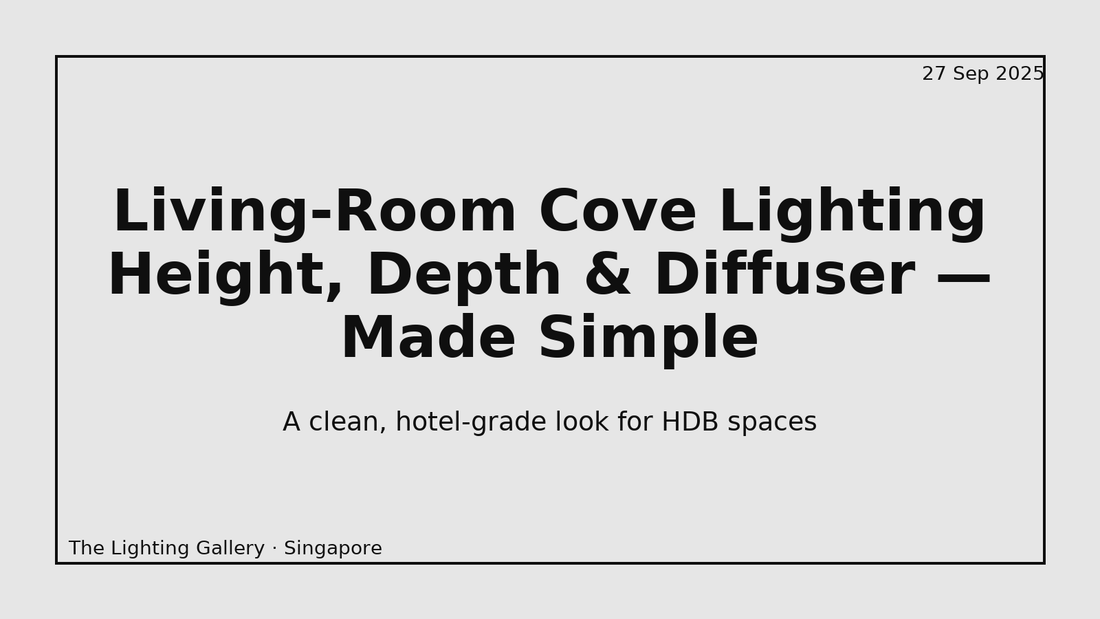
Living-Room Cove Lighting: Height, Depth & Diffuser — Made Simple
Share

1) Cove Height: Where to Place It
Goal: Soft ceiling wash with no hotspots.
- Typical HDB ceiling (2.6–2.75m): Top of cove at 150–220mm below slab.
- Why: Leaves enough throw distance for the beam to “open up” before it hits the ceiling.
- If you have ceiling fans: Keep the fan blades comfortably below the ceiling plane and offset cove away from the fan radius to avoid strobing.
Quick call: If in doubt, set the cove lip at ~200mm down from ceiling.
2) Pocket Depth & Setback: Hiding the Source
Pocket depth (clear): 60–80mm
LED strip setback from lip: 30–45mm
- Deeper pocket + proper setback = invisible light source, only glow.
- Use an aluminium profile inside the pocket to aid heat dissipation and keep lines straight.
3) Output & Dimming: Brightness You Can Live With
For living rooms, plan ambient base light at ~120–200 lux from the cove.
-
Wattage per metre (24V COB strips):
- Subtle glow: 6–8W/m
- Everyday ambient: 8–10W/m
- Bright wash (large halls): 10–12W/m
- Always pair with a dimmer; set daily use to 70–80% for comfort and strip longevity.
4) Diffuser Choice: Dot-Free by Design
- If the strip is visible at any angle, use a deep profile with opal diffuser.
- If the strip is fully hidden, COB already delivers a continuous line—an opal cover still helps blend and protect.
Colour temperature:
- Warm 2700–3000K for cosy, hotel vibe.
- Neutral 3500–4000K if the living room doubles as a workspace.
- Consider CCT-tunable if you want flexibility (Movie vs. Work scenes).
5) Driver Sizing: Never Under-Power
Use constant-voltage 24V drivers for LED strips and add safety headroom.
Driver Wattage = (Strip W/m × Total metres) × 1.25
Example: 12W/m × 6m = 72W → ×1.25 = 90W → choose 100W driver.
Voltage drop tip: Keep long runs under the recommended maximum per reel; for longer coves, power-feed from both ends.
6) Control & Scenes: Make It Effortless
- Wall dimmer for daily use.
- Add pre-sets (Movie 30%, Hosting 80%, Night 10%).
- If you already use smart assistants, choose a compatible dimmer/driver to avoid app clutter.
7) Installation Notes Contractors Appreciate
- Mark the LED tape path before carpentry/false-ceiling build.
- Run a dedicated power spur to an accessible driver location (ventilated).
- Test continuous runs on bench before closing up.
- Keep minimum bending radius of the profile and never crease LED tape.
Common Pitfalls to Avoid
- Pocket too shallow → visible diode grain and glare.
- No dimming → room feels flat or harsh at night.
- Driver hidden with poor ventilation → lifespan drops.
- Over-long single feed → voltage drop, uneven brightness.
Ready to spec your living-room cove? Share your wall-to-wall length and preferred colour temperature on WhatsApp—we’ll size the strip, profile, and driver for you and provide a fast quote.
FAQs
Q1: Can I run the cove as my only living-room light?
Yes for ambience, but add task lighting (e.g., a floor lamp or spotlights) for reading or detailed work.
Q2: Warm vs neutral—what should I choose?
Warm (2700–3000K) creates a cosy vibe. Neutral (3500–4000K) is crisper and better for multitasking spaces. If undecided, choose CCT-tunable.
Q3: Do I need an aluminium profile if the strip is hidden?
Recommended. It straightens lines, improves heat dissipation, and keeps the installation professional.
Q4: My living room is 6.5m wall-to-wall—how many feeds?
Two feeds (both ends) reduce voltage drop and keep brightness even.
